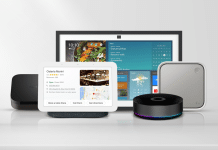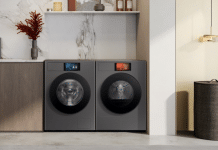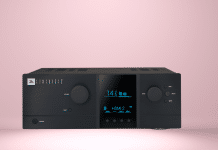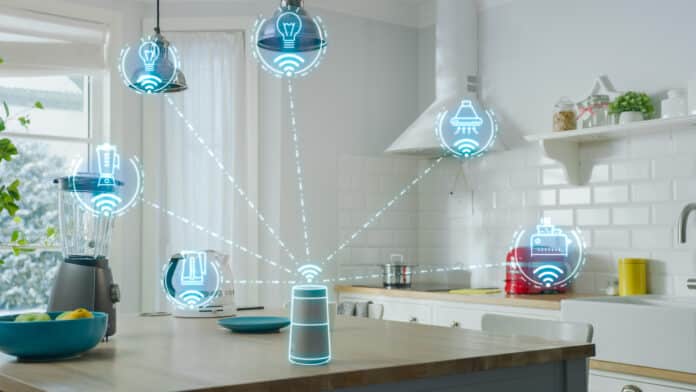
Are you ready for a new beginning by adopting Matter–the new open-source protocol that offers compatibility, security, and reliability? Smart Home World provides the latest updates on Matter read on to know more…
For those who have been following smart automation technologies closely, you have undoubtedly been reading about Matter, an open-source protocol, for a while now. Finally, there is good news: Matter has been officially launched.
For those few who are not well-versed with Matter. It is high time you brush up your knowledge on Matter, as this will soon be a universal standard for things smart home.
A brief history of the Journey so far…
On May 11, 2021, the Zigbee Alliance, a group comprising technology companies that develop, maintain, and apply global standards for the Internet of Things (IoT), announced the renaming of the organisation to the Connectivity Standards Alliance (CSA). It also announced that the Matter Standard, the latest protocol from the Connected Home Over IP (CHIP) project, was being developed.
On October 4, 2022, the international community announced the release of the Matter 1.0 specification and certification programme. This marked the beginning of a new era for IoT all over the globe.

As a part of the Matter 1.0 launch, authorised testing laboratories were opened for product certification, test harnesses and tools. Simultaneously, the open-source reference design Software Development Kit (SDK), was made accessible in order to bring new, creative products to market.
At the press conference, Tobin Richardson, President and CEO of the Connectivity Standards Alliance, explaining the importance said “What started as a mission to unravel the complexities of connectivity has resulted in Matter, a single, global IP-based protocol that will fundamentally change the IoT industry”
Matter— The Foundation of Connected Things
In December 2019, Amazon, Apple, Google, Samsung SmartThings, and the Zigbee Alliance announced that will work together on Project Connected Home over IP. The result was the creation of Matter–a unified, open-source application-layer connectivity standard that would help developers and device makers connect and build safer ecosystems, and also make connected home devices work with each other. It was built with Internet Protocol (IP) and works with both Wi-Fi and Thread networks.
Matter is a royalty-free connectivity standard that makes it easier for smart home products to work together. Its main design principle is security. Matter simplifies development for manufacturers and increases compatibility for consumers. By building on Internet Protocol (IP), Matter makes it possible for smart home devices, mobile Apps, and cloud services to talk to each other. It also lists a set of IP-based networking technologies that devices must use in order to be certified.
All the information needed to build an application and transport layer stack for Matter is explained in the Matter specification. This will guide the implementers.
Layered Architecture (In a Separate Section)
Matter aims to build a universal IPv6-based communication protocol for smart home devices. The protocol specifies the application layer that will be deployed on devices and the different link layers that will help them keep working together. The following diagram illustrates the normal operational mode of the stack:

Matter Protocol Stack: The architecture is split into layers to help separate the different tasks and give the different parts of the protocol stack a good level of encapsulation. The vast majority of interactions flow through the stack, as captured in the following figure:

The Application layer corresponds to the high order business logic of a device. For example, an application that is focused on lighting might contain logic to handle turning On/Off a light bulb, as well as its colour characteristics.
Data Model: The data layer is where the data and verb (action) elements that help the application work are stored. When the application wants to interact with the device, it uses these data structures.
Interaction Model: The Interaction Model layer describes how a client device and a server device can talk to each other. For example, the behaviour of an application on a server device would be affected by reading or writing attributes on that device. The elements defined at the data model layer are affected by these interactions.
Action Framing: Once an action is constructed using the Interaction Model, it is serialized into a prescribed packed binary format to encode for network transmission. This process is handled in the Action Framing layer.
Security: The encoded action frame is then sent down to the security layer, which encrypts and signs the payload to make sure that both the sender and receiver of a packet can trust the data.
Message Framing & Routing: When an interaction is encrypted and signed, the Message Layer builds the payload format with required and optional header fields that describe the properties of the message and how it should be sent.
IP Framing & Transport Management: After the final payload is built, it is sent to the underlying transport protocol so that IP can handle the data.
All the information about a certain type of device is stored in the top (application) layer of the protocol stack. If the device is a temperature sensor, for example, this is where the reading of the temperature would be set. This application layer has different profiles for different kinds of devices, like window break sensors, thermostats, door locks, coffee makers, and more. In this layer, commands like “turn on” or “turn off” are sent.
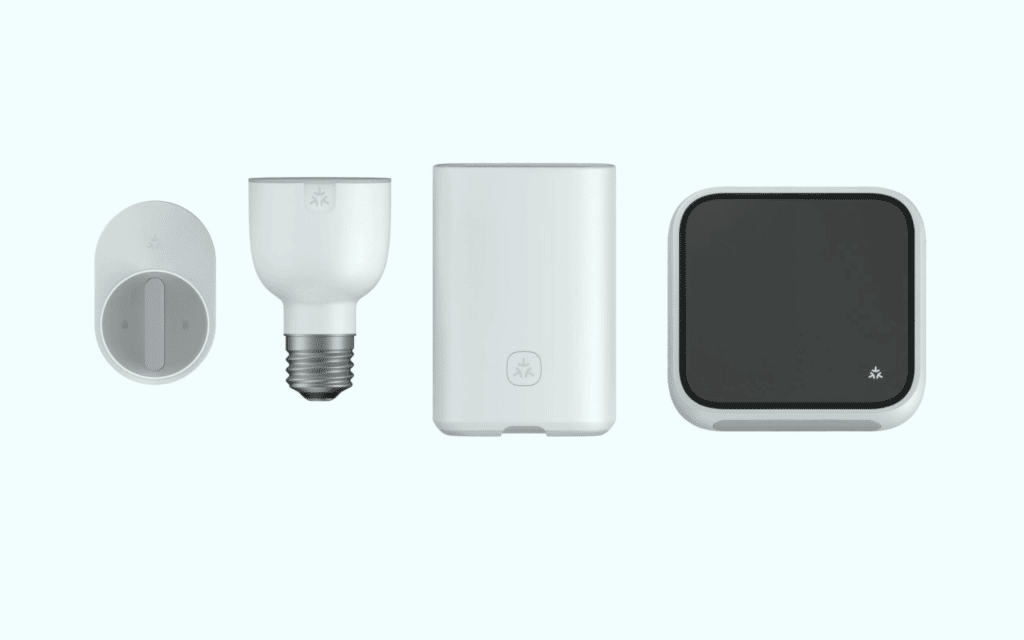
The Data Model structure comes next. This is where data from applications are organised. Then the interaction model layer defines the actions taken by the Data Model layer, such as changing the light dimming level so if anything changes it will be updated.
The Action Framing layer describes the bits and bytes of how those actions are put on the network. The Security level provides encryption, signing and authentication as well as confidentiality and protection for all the layers. The message is then framed and routed across the network via IP. Transport Management ensures that the message is delivered. If it did not get through, it is resent until it is acknowledged.
The Matter protocol stack and its open-source reference implementation are designed to work with any type of application in the smart home. Instead of being limited to just lights or a smart TV, Matter can work with any application and run on almost any hardware or operating system.
The open-source Matter software library is designed to be highly portable even working on the lowest-level devices with minimal overhead. The stack and implementation are open to anyone royalty-free and are based on the market-tested technologies known to the contributors. Apple, Amazon, Google and many others have contributed their code and concepts to make this approach work well for device makers and consumers.
How Matter Benefits End-Users
The goal of the standard is to make all smart home devices interoperable. This means that if a user buys a product with the Matter logo, they can use it with Amazon Alexa, Apple Home, Google Home, Samsung SmartThings, or any other ecosystem that meets the standard.
In a typical scenario, a user can bring a new product home and use a smartphone to scan the Quick Response (QR) code attached to the back of the product. This QR code, which is unique to that device, identifies the device and makes it possible to talk securely.

Pressing the pairing button on the device tells it to start the installation. With this prompt, the smartphone establishes a secured connection to the device using the cryptographic information included in its scanned QR code, verifies the device to determine that it really is Matter certified, determines what kind of device it is (e.g., a coffeemaker), and then sends all the necessary information (Wi-Fi passwords and more) needed for the coffeemaker to join the network.
This includes providing a new set of credentials for the coffeemaker so it can communicate securely with anything else in the smart home. The coffeemaker can now securely communicate with a smart speaker (e.g., Alexa) and can initiate a specific brewing process when commanded with a voice prompt (Alexa, make me coffee)
The goal of Matter is that if a user buys two Matter-certified devices, they will actually work together. By meeting this goal, consumers will have confidence in their purchases, and manufacturers.
“Matter makes it easier for a consumer to experiment and enter the smart home market,” says Michelle Mindala-Freeman, Head of Marketing & Member Services, CSA. “It promises three big benefits for consumers firstly greater choice in the products and ecosystems they can use, secoundly a simplified user experience and last but not the least it is a cost-effective solution.
But the benefits don’t end there. Matter will also enhance the experience of smart homes in the following ways:
Local Control: A major advantage is that rather than interacting with the servers of each device manufacturer via the internet, users can operate their gadgets directly from within their own home network. As a result, controlling functions like lighting in your smart home, such as turning them On or Off, can be quicker and continue to function even if your internet connection goes down. Thanks to the decentralised nature of the Matter standard, users won’t have to worry about their gadgets being useless if the company that produced them goes out of business or decides to shut down its servers. Matter Multi-Admin Control: Matter also allows users to control devices via multiple smart home systems at the same time through its Multi-Admin feature. That means users can turn on their lights from the SmartThings App, dim them by asking Alexa on an Amazon Echo speaker, and then turn them Off from the Apple Home app. There isn’t a hard limit to the number of different systems users can have running at the same time.
Security Concepts for the Smart Home
As these smart home systems and devices continue to get better, so do cyberattacks on them. And the risks are significant, like product malfunctions caused by remote control, DDoS (Distributed Denial of Service) attacks, data and privacy breaches, theft of intellectual property, potential harm to humans, etc. Fortunately, guidelines such as Proven Device Identity/Device Authenticity, Secure Communication, and Access Control have emerged that may be used to protect IoT devices.
Matter Security Principles
Matter addresses security as a fundamental principle. Matter functional security has been characterised by the following five characteristics:

Comprehensive: To provide comprehensive security, a layered strategy with authentication and attestation for commissioning, safeguarding every message, and securing over-the-air firmware upgrades is utilised. The security of Matter is unaffected by the underlying communication methods. E.g., Matter’s security is not based on wireless technologies such as Wi-Fi.
Strong: Matter uses a number of cutting-edge security methods. Matter uses a strong set of cryptographic techniques that have been well-tested and are standard.
AES in CCM mode is used for confidentiality and integrity with 128-bit keys.
AES in CTR mode is used for protecting identifiers to preserve privacy.
SHA-256 is used for integrity and ECC with the “secp256r1” curve for digital signatures and key exchanges, standard key derivation schemes and truly random number generators.
On top of this crypto suite, Matter relies on standard passcode-based session and certificate-based establishment protocols to establish secure sessions for onboarding, attestation, and operation.
In addition, Matter adopts the very strong concept of device attestation that implements the core concept that a Matter device cannot join a Matter fabric unless proven genuine.
To guarantee a uniform and compliant ecosystem, Matter also extends the CSA Distributed Compliance Ledger technology to Matter devices to provide an interoperable platform that allows Matter commissioner devices to check on whether the other Matter devices have been certified.
Easy To Use: Matter security is designed to make smart devices easier for device makers to implement and for consumers to use. For each functional security aspect, the Matter core specification includes examples and test vectors. Matter reference implementations, which are available to all manufacturers through a GitHub repository, include a software implementation of Matter’s functional security that is made up of separate modules. Customers who buy Matter devices won’t have to worry about security because it’s already there.
Resilient: Matter security is resilient – it’s designed to protect, detect and recover. Matter provides more than one way to perform certain operations.
Several approaches to stop the most common DoS attacks have been built into the Matter definition. The Matter protocols have been set up to work even when devices are sleeping or when group communications are being used. Matter also suggests firmware integrity attestation, which gives a measured boot and attested measurements of the firmware.
Agile: With crypto-flexibility in mind, Matter can address new developments and threats. Matter is built in such a way that new cryptographic measures can be added to future versions of Matter specification without having to change the whole specification. The modular design of the protocols also makes it possible to replace some of the old protocols with new protocols if future security risk and threat analyses show that Matter should be updated to use new protocols.
Matter Privacy Principles
Data Privacy is an important requirement of all systems that handle personal information and Matter is no exception. Data privacy is ingrained in Matter and serves as a foundational concept for all protocols and interaction methods.
Complete adherence to these principles of the General Data Protection Regulation (GDPR) and subsequent privacy regulations in other parts of the world, requires the support of the Matter standard protocols and all the supporting environments and infrastructure in which Matter devices live and operate. This is because data privacy requirements are aimed at protecting the privacy of individuals whose data is being consumed and transacted by the system of interest, and Matter protocols by design do not directly handle human-relevant information, but only information about and from interacting devices and software agents.
Platform Security
Depending on the targeted application, each Matter device implements an application layer on top of a Matter-enabled software stack, and this combination runs on a hardware platform. The hardware platform is typically an MCU, secure MCU, or SoC with an optional companion secure element, and provides core security services (APIs) available for the other software layers.
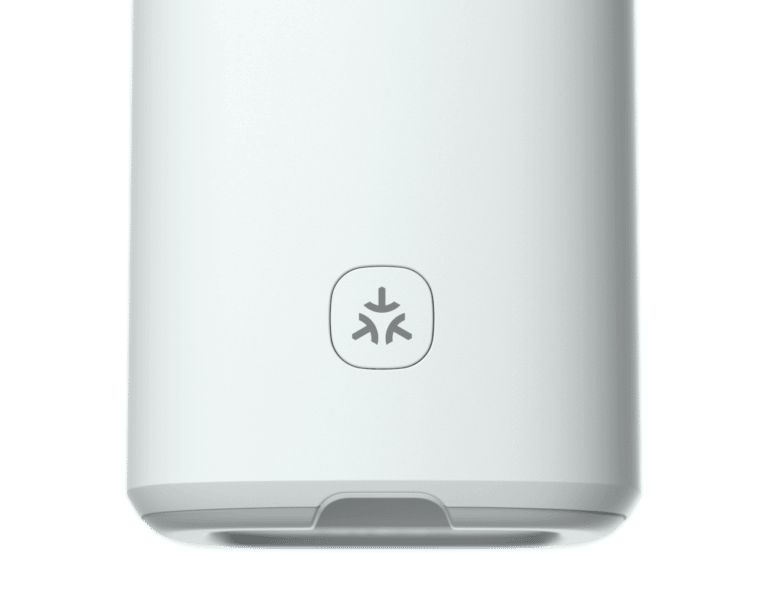
Security services such as cryptographic primitives, random number generation, secured cryptographic key storage, or even tamper resistance are then provided by the platform with a variable level of (proven) robustness against attacks depending on the platform.
Matter leaves room for the device manufacturer to select the appropriate platform security related to the risk and threat analysis of the use cases associated with their devices, as long as it does not endanger the ease of use and functionality of Matter devices.
The device manufacturer can then select the platform that best matches their needs in terms of cost, security services, and robustness against attacks, in order to concentrate on the development of their dedicated application layer while the root security services are supported by the selected platform. To illustrate this, a door lock in a public area should resist remote network attacks but may also require a tamper-resistant platform due to the threats inherent to the product use case, while tamper resistance for a light bulb inside a home area may not be necessary.
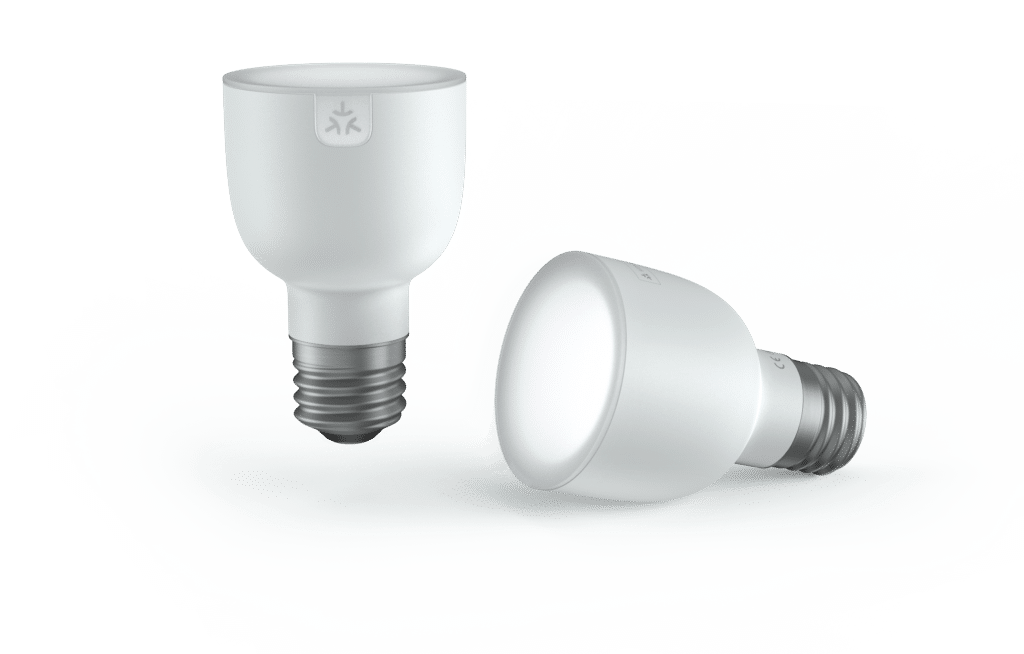
Device manufacturers can benefit from easier integration with shorter development time, and trusted security services on which to rely with strong technical support from the platform vendor. This modular approach enhances maintainability since any evolution of the cryptographic suite or robustness requirements that may be introduced in future Matter revisions can be partly or entirely managed by the platform vendor (e.g. through field update), with little impact for the device manufacturer and seamlessly from the user point of view.
The choice is left to the device manufacturer to use a Matter-ready hardware platform (i.e., with security services matching Matter needs) or to implement the needed low-level security features themselves on a more generic platform.
Matter Certification
When it comes to obtaining Matter certificates, manufacturers essentially have two options: set up their own trusted root to issue device certificates or purchase certificates from an existing root in the Matter-trusted root store.
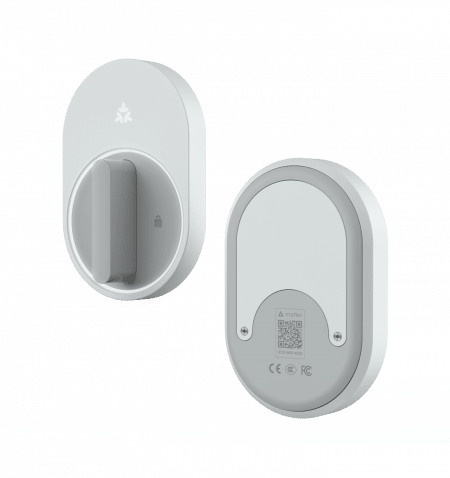
The CSA is working to define the process for submitting and accepting roots into their trust store. However, the process for acceptance into the root store will not be easy. Trusted roots will need to meet high standards and rigorous qualifications to be accepted. The website of Digicert, a digital certification and security firm, states two ways to get certified.
Option 1: Set up your own trusted root
To become a Matter-compliant Certificate Authority (CA), there are a few things to do. Operators of these roots need to meet certain requirements and do regular audits to ensure to meet certain requirements and do regular audits to make sure the highest levels of trust can be kept. Once your CA is set up, it will need to be regularly checked, updated, and managed.
Also, the Matter specification is at version 1.0 right now, with the idea that functionality will change over time. This means that root operators will need to be flexible and keep up to date if they want to keep things running smoothly. Also, manually managing a certificate’s lifecycle can lead to mistakes that cost money and hurt your reputation. DIY may seem like a way to save money, but the time and effort it takes to manage and the damage that can happen if you don’t do it right, can cost much more.
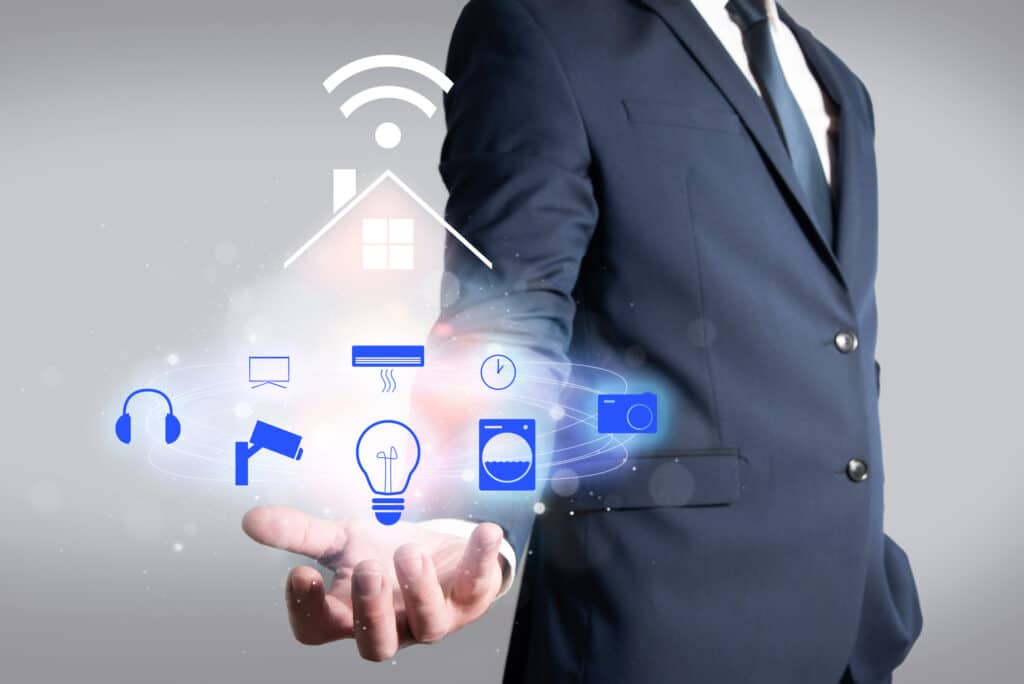
The second approach is to partner with an existing CA with a Matter-trusted root.
A far easier way to obtain Matter-trusted device certificates is to use an existing trusted root. A managed (Public Key Infrastructure) PKI service will allow faster time to market, more straightforward scalability and consultation from PKI experts. Using a private CA will offer manufacturers adopting Matter the scalability and automation capabilities they need.
In summary, using a managed PKI service is much more affordable in the long run and will be easier to set up and manage. When manufacturers choose to partner with a Matter-trusted issuing CA, they can save time, money and headache while getting Matter-trusted devices on the market faster.
Advantages of Product Certification:
- Clearly and independently indicates interoperability with products from the world’s leading brands
- Lowers barriers to market entry with access to a vast technology ecosystem
- Confirms compliance with Connectivity Standards Alliance specifications with testing from experienced professionals
The Path to product certification consists of three phases:
- Product development
- Certification testing at an Authorized Test Provider
- Application for certification with the Alliance
After your product certification is approved, companies will receive a formal certificate from the Alliance and may immediately begin using the Certified Product logo. Matter products will also receive a Certification Declaration (CD) blob file and a certified product record entered in the Distributed Compliance Ledger (DCL). Issued certifications remain valid for the lifetime of the product, which becomes immediately eligible to be listed on the Connectivity Standards Alliance database of Certified Products.
Matter Compatible Products from Major Brands
Google:
- Google Home App: Google’s new and improved Home App takes a big step towards a smart home that reflects your unique needs and is easy to navigate. Whether one has a few smart lights or they are a smart home enthusiast with dozens of Connected devices, the Google Home app will improve every smart home experience. The new App will be available in Public Preview first so users can test out the latest features and share feedback.

FEATURES→ 1. Fast Pair with Matter: With Fast Pair for Matter, devices will literally become plug-and-play. Your Android phone will automatically detect a Matter device and help you securely set it up quickly. With the launch of Matter support by Google later this year, billions of Android devices will automatically be able to set up Matter and link Apps. With new over-the-air updates, Matter devices will also be controlled by existing Google Nest smart speakers, smart displays, and routers.
- Google Nest Wi-Fi Pro 6E: Each Nest Wi-Fi Pro can accommodate nearly every connected device in a typical home and it has the speed and capacity to handle several high-bandwidth activities at the same time, like taking video calls while watching 4K videos and streaming your security cameras. One router has the power to cover up to 2,200 square feet alone.

FEATURES→ Nest Wi-Fi Pro includes a built-in Thread border router so users can connect all their Thread smart devices to their home network — and save energy, thanks to Thread’s low power mesh. Users will also be able to use their Nest Wi-Fi Pro router as a Matter hub, too. It will control and connect to all their Matter-enabled devices, making it that much easier to manage and add devices to your smart home in the future.
“From the start Google has been committed to Matter and making the smart home easier for more people. In addition to developing this open standard, we’re also launching Fast Pair for millions of Android devices and are working hard to make our Nest devices Matter controllers,” said Karen Yao, Director of Product Management, Google Home. “As we look to what’s next, we’re excited to work with our partners across the industry to help make the smart home as simple as turning on a light switch.”
Amazon:
- Matter Support Rollout: During the Matter launch celebration earlier this year in Amsterdam, Amazon announced plans to bring Matter to Amazon devices, as well as important Matter partnerships with other device makers. Amazon will focus on delivering a high-quality customer experience starting with Matter over Wi-Fi to select Echo devices and Amazon smart Plugs, Switches, and Bulbs with Android setup this year, before expanding to more operating systems, smart home products, and devices in the future.
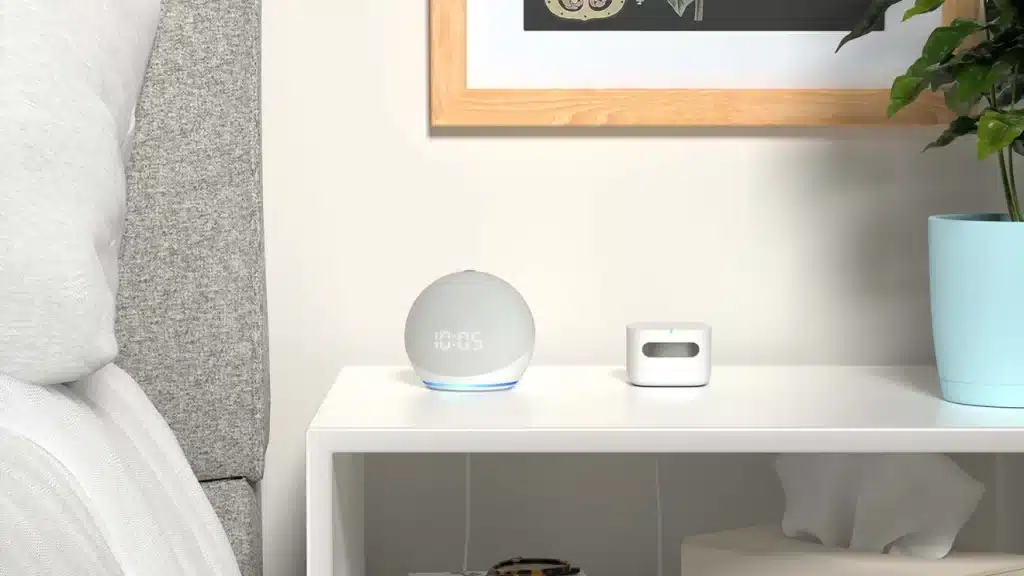
FEATURES→ Customers can mix and match more than 30,000 devices with the Works with Alexa badge (WWA), which gives them confidence that the device has been tested and certified to work with Alexa. These devices use a wide spectrum of wireless protocols including Wi-Fi, Zigbee, and Bluetooth Low Energy. Soon Matter will join them. Together with the Matter announcement, Amazon introduced new WWA certification requirements for Matter devices. They will help support innovation and choice and improve the reliability and functionality of connected devices.
“As services like Alexa continue driving rapid smart home adoption, Matter presents a new opportunity to further simplify development for device makers and add to the customer experience of smart home devices from a range of different companies and brands,” said Marja Koopmans, Director of Smart Home & Health at Amazon. “As an Alliance board member, founding company and long-time contributor to Matter, we look forward to introducing this open standard to over 100 million Echo and eero devices to make it easier for customers to set up and control their Matter-certified smart home devices.”
- Alexa Connect Kit SDK for Matter: During Alexa Live 2022, Amazon announced the Alexa Connect Kit SDK for Matter. Developers and device makers will be able to easily add local Matter connectivity to their devices while benefiting from the unique insights and capabilities provided by managed cloud connectivity.
FEATURES→ ACK SDK for Matter provides a simplified path to commercialization, actionable product insights for better customer experiences, seamless delivery of new features and mission-critical software updates, and includes features such as Frustration-Free Setup.
Nordic Semiconductors:
- nRF Connect SDK: nRF Connect SDK is a scalable and unified software development kit for building products based on all Nordic Semiconductor’s nRF52, nRF53 and nRF91 Series wireless devices. It offers developers an extensible framework for building size-optimized software for memory-constrained devices as well as powerful and complex software for more advanced devices and applications.
FEATURES For developing Bluetooth Low Energy, Thread, Zigbee and Matter products, the nRF Connect SDK contains all needed software, including protocol stacks. nRF Connect SDK also offers a unique integration of the HomeKit Accessory Development Kit for developing products using both HomeKit over Thread and HomeKit over Bluetooth Low Energy. It is a highly optimized solution that enables battery-powered products with both the HomeKit Accessory Protocol (HAP) and application firmware running on a single chip.
nRF Connect SDK offers a single code base for all devices and software components. It simplifies porting modules, libraries and drivers from one application to another, thus reducing development time. By enabling developers to pick and choose the essential software components for their application, high memory efficiency is guaranteed.
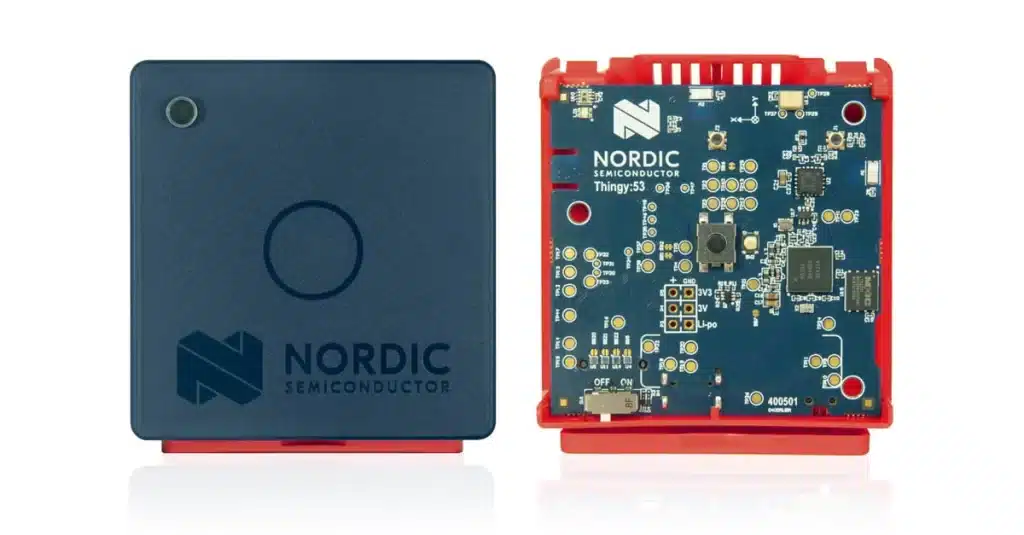
- Nordic Thingy:53
The Nordic Thingy:53™ is an easy-to-use IoT prototyping platform. It makes it possible to create prototypes and proofs of concept without building custom hardware. The Thingy:53 is built around the nRF5340 SoC, Nordic’s flagship dual-core wireless SoC. The processing power and memory size of its dual Arm Cortex-M33 processors enables it to run embedded machine learning (ML) models directly on the device.
FEATURES The nRF Edge Impulse app enables users to connect their Nordic Thingy:53 to their Edge Impulse studio account through a mobile device. It allows them to wirelessly transfer sensor data over Bluetooth LE to the mobile device and upload it to the cloud for training and download trained ML models to the Thingy:53 for deployment and inferencing.
The Bluetooth Low Energy (LE) radio allows updating firmware and communication over Bluetooth LE, and the radio also supports other protocols like Bluetooth mesh, Thread, Zigbee, and proprietary 2.4 GHz protocols. The Thread protocol compatibility also makes it a great choice when developing products for the new Matter ecosystem. Matter is a standardized application layer for connected home applications, using the Internet Protocol (IP) as the network layer.
The Thingy:53 also includes many different integrated sensors, like environmental, colour and light sensors, accelerometers, and a magnetometer, which all can be taken advantage of without additional hardware.
According to a press release by Nordic Semiconductor, Geir Langeland, Director of Sales and Marketing, said, “We believe these solutions will accelerate the potential of the IoT and wireless technology in a broad spectrum of industries as diverse as wireless audio, the smart home and asset tracking, through to health care, industrial automation and wearables.”
Apple:
Matter support in iOS 16: Apple has added support for the Matter standard in iOS 16.1, iPadOS 16.1, macOS Ventura, watchOS 9.1, tvOS 16.1, and HomePod software 16.1. Apple’s Matter implementation includes innovative privacy and security technologies and techniques designed to put users in control of their smart home experience and further interoperability between apps and ecosystems.
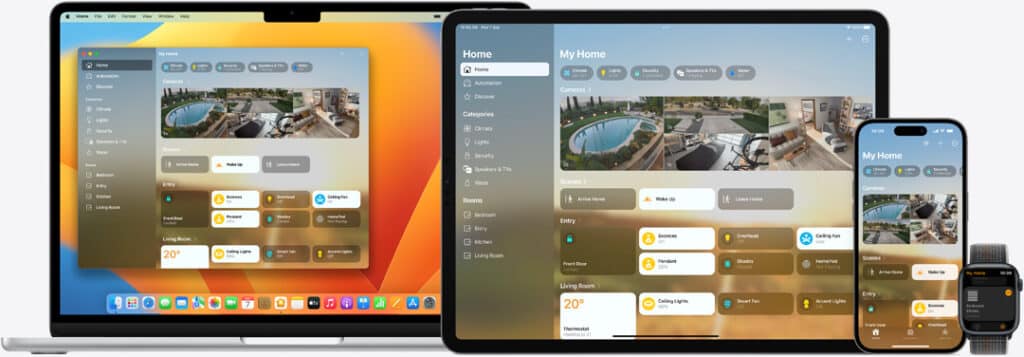
FEATURES In order to pair a Matter accessory, Apps use the new Matter Support Framework. iOS will prompt the user for permission to pair the accessory, giving users transparency and control over which accessories are added, and providing a consistent setup experience across apps.
Using the Matter Support Framework, any App that supports Matter can request to pair to nearby Matter accessories or access to accessories that were previously paired with other ecosystem apps and are stored in iOS Settings. This improves the interoperability of Matter accessories across apps and ecosystems and ensures the user is in control.
To use a Matter accessory with the Apple Home ecosystem, users can add the accessory via the Home App, or any HomeKit-based App. Once added, Apple Home transparently supports Matter accessories in the Home App, Siri, Control Center, and third-party HomeKit Apps. And, third-party Matter ecosystem Apps can also easily request users’ permission to access these accessories using the Matter Support Framework, helping promote interoperability across ecosystems.
Samsung SmartThings:
- Support for Matter: As an initial founding member, SmartThings is one of the most flexible platforms able to work with multiple protocols including, Zigbee, Z-Wave, and now, Matter, enabling consumers with existing smart homes to seamlessly integrate new devices into their homes.

FEATURES: Matter-enabled devices will join numerous products and brands already available within SmartThings’ vast ecosystem, including devices from Google, eve Systems, Honeywell Home by Resideo, Linksys, Nanoleaf, Philips Hue, Schlage, Wemo, Yale, and more.
SmartThings Hub software will also be embedded into the Samsung product portfolio, which includes Samsung Smart TVs and Family Hub refrigerators.
SmartThings supports a feature called multi-admin, which allows users to control their Matter devices from multiple platforms and apps. Samsung and Google also announced an expanded partnership to take multi-admin support to the next level, improving interoperability and offering better user experiences.
SmartThings’ Matter Controller support will begin with the second and third generations of the SmartThings Hub, as well as the Aeotec Smart Home Hub. All hubs will continue to support Zigbee, Z-Wave, and Local Area Network devices, including Wi-Fi and Ethernet, and will be upgraded over the network to enable support for Wi-Fi, Ethernet, and Thread-based Matter devices.
“We are committed to maintaining support for existing protocols while also helping the industry transition to a future built on Matter,” said Mark Tekippe, Vice President of Product at SmartThings and Connectivity Standards Alliance Board Member in a press conference at SDC 2022. “SmartThings has always provided customers with the most flexible connectivity options including Zigbee and Z-Wave. Adding support for Matter and Thread ensures SmartThings remains the most versatile ecosystem for consumers looking to build or expand their smart homes.”
Infineon:
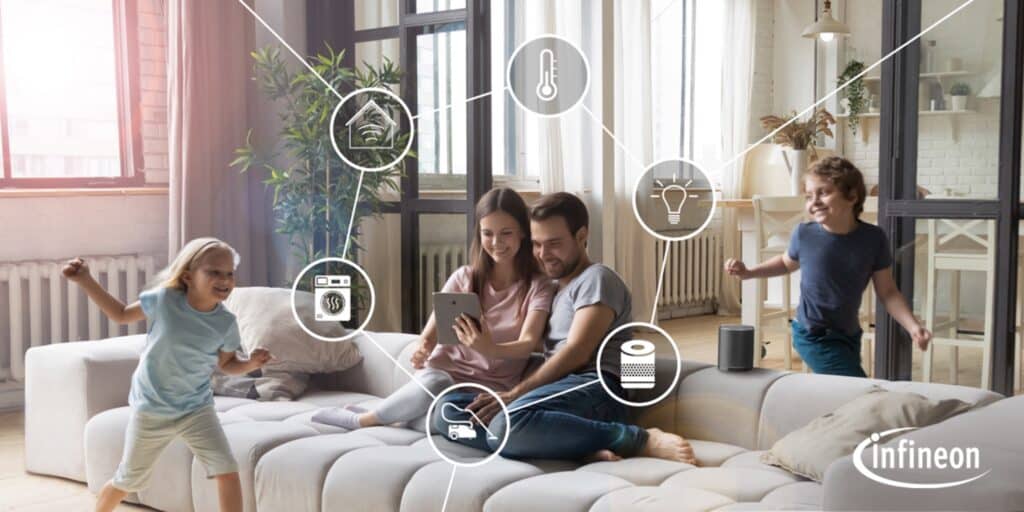
Infineon offers easy-to-integrate system solutions consisting of Matter-certified hardware and software that can be quickly integrated by a wide variety of manufacturers. Manufacturers can concentrate on their own application and, instead of having to adapt their solution to different systems, focus on one standard only.
- The combination of PSoC 6x ULP MCU and AIROC CYW43xx Bluetooth/Wi-Fi SoCs supports a very reliable, low-power implementation of Matter over Wi-Fi edge devices, while provisioning over Bluetooth or Bluetooth Low Energy.
- AIROC CYW30739 is one of the first high-performance, low-power multi-protocol SoCs to complete Thread 1.3 certification, the foundation for Matter over Thread devices.
- The new PSoC 62S2 Wi-Fi BT Pioneer Kit helps developers and engineers achieve reliable, ultra-low power Matter over Wi-Fi solutions and get to market faster.
- Matter-compatible OPTIGA security solutions easily integrate into embedded systems to protect the confidentiality, integrity and authenticity of information and devices.
Additionally, Infineon is integrating Matter software into their ModusToolbox so our customers have access to it integrated with the full suite of Infineon software and drivers to reduce time to market.
“For Infineon, it is crucial to standardise smart homes in order to promote wider adoption of digitalization for greater energy efficiency and decarbonization,” said Skip Aston, Distinguished Engineer at Infineon in a conversation with Smart Home World. “As a single, broadly endorsed standard, Matter eliminates market fragmentation and paves the way for further industry growth.”
For More Information Visit: https://csa-iot.org/all-solutions/matter/





